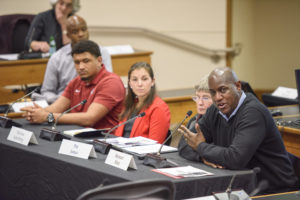In its first meeting of the new year, Faculty Senate heard reports about student athletes and emergency preparedness.

Director of Athletics Bernard Muir led a panel representing Stanford’s Department of Athletics, Physical Education and Recreation (DAPER) about tackling challenges faced by student athletes. According to the panel, Stanford’s athlete population has a 94 percent graduation rate compared to the 65 percent overall for Division I schools, and 492 student athletes received some amount of athletic scholarship for a total of $23 million in aid.
In terms of majors, the most common student athlete majors are science, technology and society (STS), human biology, management science and engineering (MS&E), computer science and political science, in that order. The list of majors overlaps with the University’s most popular majors as a whole: computer science, human biology, electrical engineering, symbolic systems and mechanical engineering. The panel acknowledged that engineering majors are harder to achieve as a student athlete. However, student representative Kevin Paloma ’17 from the football team said, “I would say [majoring in engineering as a student athlete] is doable.”
Muir also highlighted DAPER’s Cardinal Strong program, which emphasizes the entire student athlete experience and helped create the “High Performance and Education” dinner program open to all students after regular dining hours.
In addition, DAPER created the Student-Athlete Civic Engagement program (ACE) to help with the difficulties student athletes face going abroad. Students in the program go abroad during the summer to four countries for three weeks each; the ACE program specifically chooses locations with gyms to minimize the impact on the athletes’ training schedules. According to Muir, the feedback from the ACE’s two cohorts has been positive.
After the report from DAPER, University emergency manager Keith Perry and Director of Research Safety Russell Furr presented on Stanford’s emergency preparedness, which is coordinated by Environmental Health and Safety.
“We [the professionals at Environmental Health and Safety] use an all-hazards approach,” Perry said, adding that Environmental Health and Safety develops strategies and protocols that form a toolbox allowing responders to be flexible.
Perry said that there are three different emergency levels. Level one, the least severe level, includes local emergencies like heart attacks or water pipe breaks. Incidents causing minor to moderate campus impact, which include power outages, gas pipe breaks or infectious disease outbreaks, form level two. Finally, the most severe issues like earthquakes and active shooters are in level three and demand the attention of all of the University’s emergency response resources.
Given that incidents in level one and two are more common, Perry said, these situations help Environmental Health and Safety improve their strategies for level three situations.
Provost Persis Drell also announced that the Allan V. Cox Medal for Faculty Excellence Fostering Undergraduate Research has been suspended due to the revelations regarding Cox’s sexual misconduct. Drell said that the decision regarding the future of a prize recognizing faculty work in fostering undergraduate research is still under discussion and could possibly include a renaming of the medal.
Contact Christina Pan at capan ‘at’ stanford.edu.
